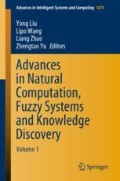Abstract
Cognitive agents should be equipped with computational methods enabling autonomous extraction of internal cognitive structures, i.e., supporting organization of large datasets and facilitating interaction with human users. In this research, we focus solely on the extraction of basic-level categories. We propose a computational approach that allows the agent to develop, through individual interaction with the external world, provisional clusters (using hierarchal clustering techniques) and filter them, using predefined measures of basic-levelness (inspired by psycholinguistic research). We focus on analysing the behaviour of two proposed computational approaches, namely dendrogram and multidendrogram, to establishing provisional clusters. Further, the approach is extensively studied through an array of simulations. Obtained results highlight that the proposed methods can be used to extract basic-level categories.
Access this chapter
Tax calculation will be finalised at checkout
Purchases are for personal use only
Notes
- 1.
Basic binarization process was performed for non-binary attributes.
- 2.
Value should be minimized for AS measure and maximized for remaining ones.
References
Bornstein, M.H., Arterberry, M.E.: The development of object categorization in young children: hierarchical inclusiveness, age, perceptual attribute, and group versus individual analyses (2010)
Corter, J.E., Gluck, M.A.: Explaining basic categories: feature predictability and information. Psychol. Bull. 111(2), 291–303 (1992)
Corter, J.E., Gluck, M.A., Bower, G.H.: Proceedings of the Tenth Annual Conference of the Cognitive Science Society (1988)
Fernández, A., Gómez, S.: Solving non-uniqueness in agglomerative hierarchical clustering using multidendrograms. J. Classif. 25(1), 43–65 (2008)
Gosselin, F., Schyns, P.: Debunking the basic level. In: Cognitive Science Society (US) Conference/Proceedings, pp. 277–282 (1997)
Harnad, S.: To cognize is to categorize: cognition is categorization. In: Lefebvre, C., Cohen, H. (eds.) Handbook of Categorization. Elsevier, Amsterdam (2005)
Hoffmann, J., Ziessler, C.: Objektidentifikation in künstlichen Begriffshierarchien. Object Ident. Artif. Conceptual Hierarchies 191(2), 135–167 (1983)
Jones, G.V.: Identifying basic categories. Psychol. Bull. 94(3), 423–428 (1983)
Mulka, M., Lorkiewicz, W.: Measures for extracting basic-level categories. In: 2018 11th International Congress on Image and Signal Processing, BioMedical Engineering and Informatics (CISP-BMEI), pp. 1–6 (2018)
Murphy, G.L.: Parts in object concepts: experiments with artificial categories. Mem. Cogn. 19(5), 423–438 (1991)
Murphy, G.L., Smith, E.E.: Basic-level superiority in picture categorization. J. Verbal Learn. Verbal Behav. 21(1), 1–20 (1982)
Rosch, E., Mervis, C.B., Gray, W.D., Johnson, D.M., Boyes-Braem, P.: Basic objects in natural categories. Cogn. Psychol. 8(3), 382–439 (1976)
Saxena, A., Prasad, M., Gupta, A., Bharill, N., Patel, O.P., Tiwari, A., Er, M.J., Ding, W., Lin, C.T.: A review of clustering techniques and developments. Neurocomputing 267, 664–681 (2017)
Tanaka, J.W., Taylor, M.: Object categories and expertise: Is the basic-level in the eye of the beholder? Cogn. Psychol. 23, 457–482 (1991)
Tversky, A.: Features of similarity. Psychol. Rev. 84(4), 327–352 (1977)
Tversky, B., Hemenway, K.: Objects, parts, and categories. J. Exp. Psychol. Gen. 113(2), 169–193 (1984)
Acknowledgment
This research was carried out at Wrocław University of Science and Technology (Poland) under Grant 0401/0190/18 titled Models and Methods of Semantic Communication in Cyber-Physical Systems.
Author information
Authors and Affiliations
Corresponding author
Editor information
Editors and Affiliations
Rights and permissions
Copyright information
© 2020 Springer Nature Switzerland AG
About this paper
Cite this paper
Mulka, M., Lorkiewicz, W., Katarzyniak, R.P. (2020). Extraction of Basic-Level Categories Using Dendrogram and Multidendrogram. In: Liu, Y., Wang, L., Zhao, L., Yu, Z. (eds) Advances in Natural Computation, Fuzzy Systems and Knowledge Discovery. ICNC-FSKD 2019. Advances in Intelligent Systems and Computing, vol 1074. Springer, Cham. https://doi.org/10.1007/978-3-030-32456-8_25
Download citation
DOI: https://doi.org/10.1007/978-3-030-32456-8_25
Published:
Publisher Name: Springer, Cham
Print ISBN: 978-3-030-32455-1
Online ISBN: 978-3-030-32456-8
eBook Packages: Intelligent Technologies and RoboticsIntelligent Technologies and Robotics (R0)

